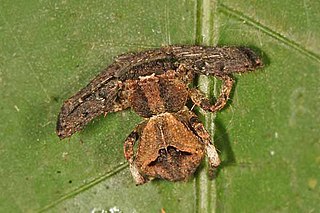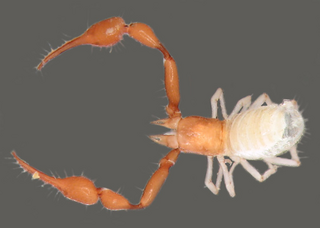
Amblypygi is an order of arachnid chelicerate arthropods also known as whip spiders or tailless whip scorpions, not to be confused with whip scorpions or vinegaroons that belong to the related order Thelyphonida. The name "amblypygid" means "blunt tail", a reference to a lack of the flagellum that is otherwise seen in whip scorpions. Amblypygids possess no silk glands or venomous fangs. They rarely bite if threatened, but can grab fingers with their pedipalps, resulting in thorn-like puncture injuries.

Thiania is a genus of jumping spiders that was first described by Carl Ludwig Koch in 1846.

Charinidae is an arachnid family within the order of tailless whip scorpions.
Zalmoxis is a genus of harvestmen, within the Zalmoxidae family. They are found in tropical Australia, Borneo, New Guinea, the Philippines and on Pacific islands.

Jerzego is a spider genus of the jumping spider family, Salticidae, with three described species native to Asia.

Phrynus is a genus of whip spiders found in tropical and subtropical regions, mostly in the new world.

Phlogiellus is a genus of tarantulas that was first described by Reginald Innes Pocock in 1897. They are found throughout Asia and Papua New Guinea, including Indonesia, the Philippines, Papua New Guinea, China, Myanmar, Malaysia, Borneo, Thailand, the Solomon Islands and Taiwan. Phlogiellus is part Latin and part Greek, the first part being "φλóξ φλoγóϛ", meaning flame, the second part being "ellus" which is a latin diminutive suffix.
Epidius is a genus of crab spiders that was first described by Tamerlan Thorell in 1877. It is a senior synonym of Pothaeus.
Rhitymna is a genus of huntsman spiders described in 1897 by Eugène Simon. Members of this genus can be distinguished by a number of characteristics, but it is most often confused with Olios species, many of which also have the Y-shaped pattern on the dorsal opisthosoma.

Angaeus is a genus of Asian crab spiders first described by Tamerlan Thorell in 1881. It is considered a senior synonym of Paraborboropactus.
Cebrenninus is a genus of crab spiders that was first described by S. P. Benjamin in 2016. It is a senior synonym of Ascurisoma.

Lusoblothrus is a genus of pseudoscorpions in the family Syarinidae. The genus was created to accommodate its sole species, Lusoblothrus aenigmaticus. The species was recently discovered in Portugal, its description published in 2012.
Phrynichus is a genus of tailless whipscorpions in the family Phrynichidae. There are about 16 described species in Phrynichus.

Paracharon is a genus of tailless whip scorpion. A single species, Paracharon caecus has been described. It is endemic to Guinea-Bissau in West Africa It is one of two living genera of the family Paracharontidae, alongside the South American Jorottui. It is a troglobite having no eyes, with P. caecus found living in termite nests.
Charinus is a genus of amblypygids (whip-spiders) of the family Charinidae.
Weygoldtia is a genus of amblypygids of the family Charinidae, described in 2018 by Gustavo Silva de Miranda, Alessandro P.L. Giupponi, Lorenzo Prendini and Nikolaj Scharff. The genus is named after the German arachnologist Peter Weygoldt, in recognition of his contributions to the study of Amblypygi.

Paracharontidae is an arachnid family within the order Amblypygi. Paracharontidae and the extinct Weygoldtinidae from the Carboniferous form the suborder Paleoamblypygi, the sister group to the remaining Amblypygi. The family contains two genera: Paracharon, containing the single species Paracharon caecus Hansen, 1921 from Guinea-Bissau in West Africa, and Jorottui with the single species Jorottui ipuanai from Colombia in northern South America. Paracharonopsis from the Eocene (Ypresian) aged Cambay amber of India was initially assigned to this family but this was later questioned and it has since been reassigned to Euamblypygi. Both living species are troglobites, having no eyes, with P. caecus living in termite nests, while J. ipuanai inhabits caves.
Catageus is a genus of amblypygids of the family Charontidae.








